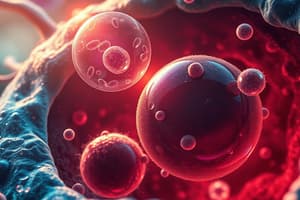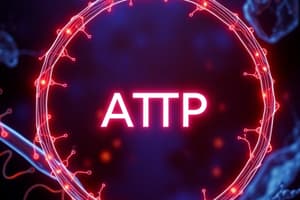Podcast
Questions and Answers
What organelle is known as the powerhouse of the cell and is responsible for energy release?
What organelle is known as the powerhouse of the cell and is responsible for energy release?
Mitochondria
How is the structure of red blood cells adapted to their function in transporting oxygen?
How is the structure of red blood cells adapted to their function in transporting oxygen?
They have a biconcave shape for greater surface area and lack a nucleus to maximize hemoglobin content.
What distinguishes phagocyte blood cells in terms of structure and function?
What distinguishes phagocyte blood cells in terms of structure and function?
They have a flexible shape to engulf microorganisms and a lobed nucleus for adaptability.
What is the role of lymphocytes in the immune system?
What is the role of lymphocytes in the immune system?
In what way does the structure of nerve cells (neurons) support their function?
In what way does the structure of nerve cells (neurons) support their function?
Describe a key feature of sperm cells that enables them to fertilize an egg.
Describe a key feature of sperm cells that enables them to fertilize an egg.
What primary function does the mitochondria perform in the cell?
What primary function does the mitochondria perform in the cell?
Why do red blood cells not have a nucleus?
Why do red blood cells not have a nucleus?
What is the main function of the mitochondria in the mid section of sperm cells?
What is the main function of the mitochondria in the mid section of sperm cells?
What is the primary role of root hair cells?
What is the primary role of root hair cells?
How do palisade cells contribute to photosynthesis?
How do palisade cells contribute to photosynthesis?
What role do ciliated cells play in the respiratory system?
What role do ciliated cells play in the respiratory system?
What are the main components of an egg cell (ovum) that support embryo development?
What are the main components of an egg cell (ovum) that support embryo development?
What feature of guard cells helps regulate gas exchange?
What feature of guard cells helps regulate gas exchange?
How is magnification defined in relation to images and objects?
How is magnification defined in relation to images and objects?
What can happen to ciliated cells if a person smokes?
What can happen to ciliated cells if a person smokes?
Flashcards
Red blood cell
Red blood cell
A cell that carries oxygen from the lungs to the body and carbon dioxide back to the lungs.
What is the structure of a red blood cell?
What is the structure of a red blood cell?
A cell with a biconcave shape, which increases its surface area for oxygen diffusion. It contains haemoglobin, which carries oxygen, and lacks a nucleus to provide more space for haemoglobin.
Phagocyte
Phagocyte
A white blood cell that is flexible and can engulf microbes like bacteria or viruses.
B-Lymphocyte
B-Lymphocyte
Signup and view all the flashcards
Role of B-Lymphocytes
Role of B-Lymphocytes
Signup and view all the flashcards
Nerve cell (Neuron)
Nerve cell (Neuron)
Signup and view all the flashcards
What is the structure and function of a nerve cell?
What is the structure and function of a nerve cell?
Signup and view all the flashcards
Describe a nerve cell
Describe a nerve cell
Signup and view all the flashcards
Sperm cell
Sperm cell
Signup and view all the flashcards
Ciliated cell
Ciliated cell
Signup and view all the flashcards
Root hair cell
Root hair cell
Signup and view all the flashcards
Palisade cell
Palisade cell
Signup and view all the flashcards
Egg (ovum) cell
Egg (ovum) cell
Signup and view all the flashcards
Magnification
Magnification
Signup and view all the flashcards
Guard cells
Guard cells
Signup and view all the flashcards
Rods and cones
Rods and cones
Signup and view all the flashcards
Study Notes
Starter Activity
- Students need to answer a question.
- The answers are written on mini white boards.
Mitochondria
- Known as the powerhouse of the cell.
- Releases energy through respiration.
- Contains DNA, controlling cell activities.
- Responsible for protein synthesis.
- Found in all prokaryotes but only some eukaryotes.
- Present in plant cells, algae, and some prokaryotes.
Learning Objectives
- Understanding specialised cells and magnification calculations.
- Describing how specialised cells are adapted to their function.
Cell Types (Images)
- Diagrams show a phagocyte and a lymphocyte.
- Labelled parts include the nucleus and cytoplasm.
Red Blood Cells
- Structure:
- Biconcave shape for greater surface area (diffusion of oxygen).
- Contains haemoglobin (carries oxygen).
- Lacks a nucleus (maximizes space for haemoglobin).
- Flexible shape to fit through capillaries.
- Function:
- Carry oxygen from lungs to body, and carbon dioxide back to lungs.
Phagocyte
- Structure:
- Flexible shape to engulf microorganisms.
- Lobed nucleus.
- Function:
- Found in blood.
- Attracted to diseases, bacteria.
- Engulfs bacteria/pathogens, preventing infection.
B Lymphocyte
- Structure:
- White blood cell with surface receptors.
- Function:
- Produces antibodies to destroy pathogens (recognising antigens).
- Reproduces rapidly, making copies of antibodies to neutralize pathogens.
Neuron
- Structure:
- Elongated cells (long cells).
- Branches at both ends to connect to other nerve cells.
- Long axon (main branch) covered in myelin sheath (fat) - preventing electrical impulses from affecting surrounding parts of the body.
- Function:
- Carry nerve impulses throughout the body.
Sperm Cell
- Structure:
- Long tail for movement.
- Enzymes (acrosome) to penetrate the ovum.
- Many mitochondria for energy.
- Made in male testes.
- Function:
- Carry genetic material (DNA) to fertilize the egg.
Root Hair Cell
- Structure:
- Large surface area to absorb water.
- Thin cell wall for easy water passage.
- Lacks chloroplasts.
- May contain many mitochondria for active transport of mineral ions.
- Function:
- Absorbs minerals and water from soil.
Palisade Cell
- Structure:
- Tall shape with large surface area to capture sunlight.
- Packed with chloroplasts for photosynthesis.
- Located beneath the epidermis to allow light passage.
- Regular shape for packing in a small area.
- Function:
- Perform photosynthesis.
Ciliated Cell
- Structure:
- Lines air passages and oviducts.
- Tiny hairs (cilia).
- Function:
- Prevents lung damage.
- Moves mucus with trapped dust/bacteria to throat for swallowing.
- Smoking can damage cilia and affect mucus removal.
Ovum (Egg Cell)
- Structure:
- Cytoplasm with organelles.
- Protective coat.
- Function:
- Energy source for developing embryo.
- Contains mother's genetic material for fertilization.
Rods and Cones
- Structure (Rods and Cones):
- Outer segments contain photosensitive chemicals.
- Nucleus present.
- Description includes differences:
- specialized receptors in the eye
Guard Cells
- Structure:
- Contain chloroplasts.
- Thin outer wall, thick inner wall.
- Control the opening and closing of stomata (pores in leaves).
- Function:
- Regulate gas exchange and water loss in plants.
Magnification Calculations
- Formula: Magnification = Size of image / Actual size of specimen.
- Triangle diagram to illustrate the relation between these factors.
- Methods to convert between units (e.g., mm, μm, nm)
- Examples: Conversion between units to convert a size.
Additional Information: Microscopy units
- There are three units: millimetre (mm), micrometre (μm), and nanometre (nm).
- Conversion factors: 1 metre = 1000 mm, 1 mm = 1000 μm, 1 μm = 1000 nm
- Instructions to multiply/divide based on the conversion.
Studying That Suits You
Use AI to generate personalized quizzes and flashcards to suit your learning preferences.




